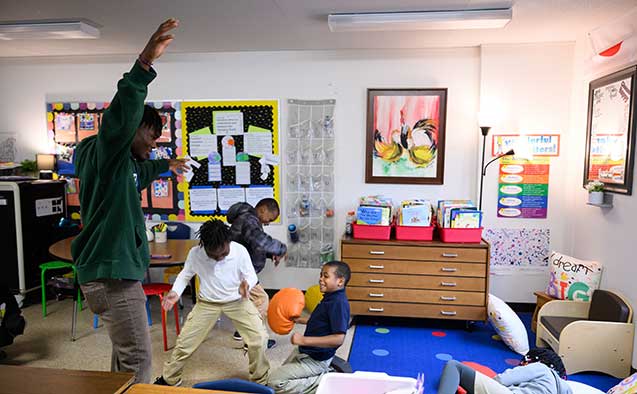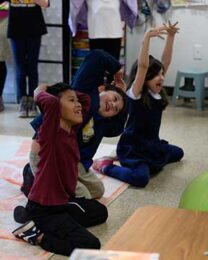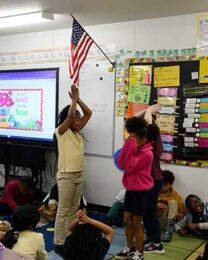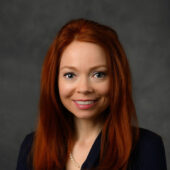How the performing arts can teach kids concepts in science
Wake Forest partners with Speas Elementary for innovative program

Highlights
- Wake Forest partners with Speas Elementary for program that blends performing arts with science education.
- Wake students design the lessons for second graders using body movements to teach science.
- Teachers gain new instructional ideas.
It’s a Tuesday afternoon at Speas Elementary in Winston-Salem. Second grade students are returning from recess and the energy level inside classrooms is running high.
“I’m a little nervous,” said Wake Forest junior Kate Leffler, who is majoring in psychology and minoring in education and neuroscience. “You can prepare as much as possible, but it’s really about adapting your lesson and trying to meet kids where they are.”
Environmental studies and theatre student Jane Ivey Johnson also steps to the front of the classroom and they are ready to get started.
Today’s lesson: liquids and solids.
Acting out science concepts
“I’m the sun and you are a snowman,” Leffler said. “I’m moving closer to you. Show me what happens next.”
 The second graders begin using their body movements to demonstrate how the snowman turns to liquid from the heat. As the kids wiggle their way up and down to the floor and get creative with their responses, they are experiencing hands-on learning and mastering one of the State of North Carolina’s science standards. It’s all part of an innovative program called Theatre in Education.
The second graders begin using their body movements to demonstrate how the snowman turns to liquid from the heat. As the kids wiggle their way up and down to the floor and get creative with their responses, they are experiencing hands-on learning and mastering one of the State of North Carolina’s science standards. It’s all part of an innovative program called Theatre in Education.
Wake Forest University is collaborating with Speas Elementary and Winston-Salem/Forsyth County Schools for the initiative.
Sixteen WFU education and theater students are working with seven classes of Speas second graders this spring using the performing arts to teach lessons on weather patterns, the properties of liquids and solids and other science topics.
“We know kids learn in different ways,” said Brook Davis, a professor in the Department of Theatre and Dance.
“Overwhelming research points to the success in learning outcomes when students are creatively engaged in class content.” Brook Davis, program co-leader
Davis leads the program with Associate Professor of Education Alan Brown. Their students are paired in teams and become content creators and teachers during weekly visits in Speas classrooms.
“For years, Brook Davis [Theatre], Christina Soriano [Dance], and I have collaborated on various interdisciplinary projects that connect education and the arts with a focus on movement, performance, and literacy. We find that bringing together Wake Forest students from across majors and minors and putting them in front of elementary school students using these teaching methods offers unparalleled opportunities for student growth on both sides of the age spectrum.”
 Just a few doors down the hallway, kids are sitting in a circle on a bright-colored mat as they learn more about weather conditions and climate. They slowly rise, using their bodies and facial expressions to act out how a thermometer reacts to changes in temperature.
Just a few doors down the hallway, kids are sitting in a circle on a bright-colored mat as they learn more about weather conditions and climate. They slowly rise, using their bodies and facial expressions to act out how a thermometer reacts to changes in temperature.
“This is so fun,” said 8-year-old Lucia Haymes. “I can’t wait for Tuesdays because that’s when Wake Forest students are here in my class. “I love science and the games that we are doing make it easier.”
Extending learning beyond the classroom
“We are excited about this collaboration that helps support our teachers in the classroom,” said Katryna Jacober, the International Baccalaureate Coordinator (IB) at Speas. “Our school system’s big buzz word this year is deeper learning, so by them actually focusing on it and figuring out how the body would move to represent weather measuring equipment or a science concept is going to help them carry that knowledge forward when they get to another grade level.”
For Keilah Reeves, a second-grade educator at Speas, the collaboration is making a big difference in her first year of teaching.
“It’s been a really great experience working with Wake students and getting multiple perspectives,” said Reeves.
“It’s given me ideas to be creative and implement these types of activities into my own lessons.” Keilah Reeves - Speas Elementary teacher
Blanca Basurto, a second-grade dual language immersion teacher at Speas, says the program not only helps kids grow their vocabulary, but it also encourages all students to participate.
“I hope this partnership continues because I have seen so many benefits at Speas,” said Basurto. “They get to incorporate more movement and this is a chance for the children to get out of their seats and touch back on what we have learned, but in a different way through art, so that’s wonderful.”
Creating lasting impact
A lot of advance preparation goes into each 45-minute class. Wake Forest students meet every Thursday to reflect on their previous lesson, plan for the following week, and practice their science-related activities.
The program has reinforced Wake Forest senior Kristen O’Sullivan’s career decision. The psychology major and education minor plans to become an elementary teacher after she graduates.
“I think it really speaks to how strong the education department is here and how willing they are to be innovative.”
As this week’s class at Speas comes to an end, education student Sidney Paris also reflects on the day.
“I’m learning just as much if not more from these kids, and I think it’s awesome to be able to do something in the community,” Paris said. “The most gratifying thing for me is when we get there and all the students are so happy to see us and they come up and give us hugs, a big group hug at the end.”
The Theatre in Education collaboration will serve as a model for the new Wake Forest Center for Literacy Education that will be launched later this year.
Program leaders have also partnered with other public schools in Winston-Salem/Forsyth County Schools to infuse performing arts into math, social studies, literacy, and other curriculum.
Categories: University Announcements
Wake Forest News
336.758.5237
media@wfu.edu
Meet the News Team
Wake Forest in the News
Wake Forest regularly appears in media outlets around the world.




